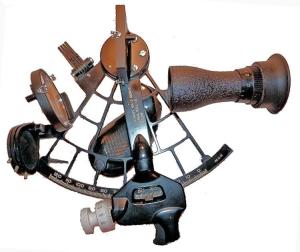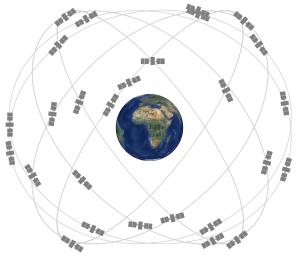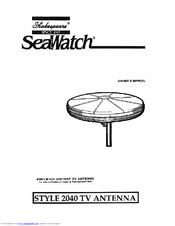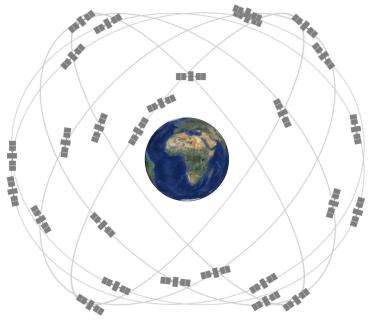Jamming and Spoofing: Challenges to GPS
“Safety Moments, presented at CCA Stations and Posts”
By Chuck Hawley, San Francisco Station

It may be too soon to store your sextant, sight reduction tables, chronometer, and that funny starfinder which consisted of disks which when lined up correctly could show you a very small model of the heavens. That’s because one of the navigational marvels of the late 20th Century is now facing attacks that may render it inaccurate, if not altogether missing in action. That navigational marvel is, of course, GPS and its variants (European Galileo, Russian GLONASS, Chinese Beidou.) An article in WIRED Magazine, The Dangerous Rise of GPS Attacks, April 30, 2024, documents the increasing number of electronic attacks on the GPS system.
One of the marvels of the GPS system is that the satellites are in an orbit approximately 12,550 miles up, a so-called medium earth orbit, or MEO constellation, and as a result they orbit the Earth twice a day. The

height of the orbit gives each satellite the ability to see 38% of the Earth’s surface, and thus fewer satellites are required to provide the necessary 4 satellites (and preferably more) for a 3-D fix. This also means that the satellite signals are very weak when they reach the receiver, and have to be carefully extracted from the background electronic noise using something called pseudo random codes, or PRCs. This is a lengthy digital code which allows the satellites to operate on the same frequency, at low power, and still get their messages to a GPS receiver on the surface of the Earth (or in the sky, in the case of aircraft.)
It is this aspect of the GPS system, this low power signal, that makes it especially susceptible to purposeful interference, compared to previous navigational technologies like Loran-C. Loran-C signals were transmitted from stations that had tall antennas (around 600’) with transmitter power from 100 to 4,000 kilowatts. The expense of setting up a “pirate” Loran-C station would be prohibitive for all but the most dedicated saboteur. Not so, however, with the costs of sending out erroneous GPS signals that can wreak havoc with GPS receivers.

There are two types of GPS signal interference. The first is jamming, or the transmission of strong signals compared to the legit satellite signals that overwhelm the receiver on the vessel or aircraft. The GPS receiver can’t detect the PRC signal from the satellite(s) and therefore can’t compute its position. Sometimes this is intended (bad hombres) and sometimes it is inadvertent due to poor design. In the early 2000s, Shakespeare marketed two models of TV antenna for boats and RVs that had a small amplifier that interfered with GPS signals (Model 2040 and 2050, made in 2000.) The TV coverage of the 34th America’s Cup, which was highly dependent on accurate positional information, was susceptible to the noise from this particular antenna, and the television crew would have to search for the offending antenna when preparing for a broadcast. Shakespeare readily admitted that they had a problem and retrofitted the offending antennas with GPS friendly models.
The other type of interference is spoofing, or the transmission of seemingly correct signals that result in an erroneous fix. The Wired article goes into great detail on how spoofing has increased, primarily in Eastern and Central Europe, to the point that aircraft have had to return to their originating airports due to spoofing at their destinations, and the simultaneous erroneous navigational fixes of dozens of ships showing them to be on land.
All is not lost, however, as there are improvements to the various GPS signals that are intended to make spoofing more difficult. While most of the changes apply to military-only use, it’s possible that the anti-spoofing code changes could make it to civilian users.
CCA member Stan Honey points out that proximity, especially being in the line-of-sight of the “spoofer” is necessary for spoofing to work. Since many of the most critical users for GPS would be in the line-of-sight of potential spoofers (aircraft landing and taking off, ships in harbors, delivery vans dependent on vehicle navigation), this may be a small comfort, but a vessels and aircraft move away from shore, the opportunity to spoof drops dramatically.
It’s also possible that spoofing or jamming may be used by “good guys” to protect individuals, buildings, or military bases. CCA member Michael Moradzadeh noticed that GPS ceased to work when he visited the White House. He also mentions that even if spoofing and jamming aren’t the problem, the satellite system is still vulnerable to possible military action, space junk collisions, or interference from your own boat (as Michael has experienced.)
Whether it’s intentional or accidental spoofing or jamming, all mariners (and aviators and hikers) should be diligent in never relying on a single source of positional information. The use of visual and radio bearings, depth information, visual verification of map data, celestial fixes, dead reckoning, etc. should be a complement to GPS and its related satellite-based systems.
The Cruising Club of America is a collection of accomplished ocean sailors having extensive boat handling, seamanship, and command experience honed over many years. “Safety Moments” are written by the Club’s Safety Officers from CCA Stations across North America and Bermuda, as well as CCA members at large. They are published by the CCA Safety and Seamanship Committee and are intended to advance seamanship and safety by highlighting new technologies, suggestions for safe operation and reports of maritime disasters around the world.






